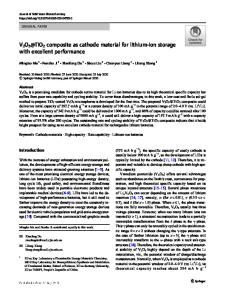Electrochemical Lithium Intercalation into Nb 2 O 5 Cathode for 2 V Class-Secondary Lithium Batteries
- PDF / 1,017,447 Bytes
- 9 Pages / 417.6 x 639 pts Page_size
- 59 Downloads / 324 Views
ABSTRACT Nb2O5 powder was prepared by heating niobium hydroxide in the temperature range from 600 to 1000°C. The crystal system of Nb2 0 5 compounds depended on the heating temperatures, i.e., hexagonal, orthorhombic and monoclinic Nb20 5 compounds were obtained at 600, 800 and 1000°C, respectively. Electrochemical lithium intercalation into the three Nb 20 compounds was investigated in a cell with an LiClO 4 -propylene carbonate electrolytic solution for the application as lithium battery cathodes. As a result, they displayed good charge-discharge performance as the cathode of 2 V class-lithium battery, which will play important role in power supply for IC memory backup developed recently. The thermodynamics and kinetics of the lithium intercalation into the Nb 20 5 cathode have been investigated. The thermodynamic parameters, such as standard free energies, lithium partial molar entropy, interaction energies between ions, the crystal lattice parameters, and the kinetic parameters, such as chemical and self diffusion constants, have been obtained as a function of x-value in Li•Nb 2O 5. INTRODUCTION In recent years, great interest has been centered on the development of secondary lithium batteries consisting of lithium intercalation electrodes. Many researchers focus on the cathodes which possess the higher voltage versus a carbon (or lithium metal) anode for the reason that high voltage cathodes essentially have an advantage for highly specific energy density of rechargeable batteries in the case of the same capacity cathode. On the other hand, running voltage of integrated circuit (IC) in cellular phones, camcorders and laptop computers is recently reducing from about 3 V to 2.5 V with the advance of IC microfabrication technology, and it will be 1.9 V in near future. Hence, rechargeable micro-batteries which can be charged fully in the same voltage range, i.e., around 2.5 - 1.9 V, would be required for power supply of the IC memory backup. If such rechargeable lithium batteries are applied for this supply, there is a remarkable advantage for reducing the total weight of portable electric devices because of its high energy density and no requirement of a voltage adjuster in the devices' body. On the basis upon this viewpoint, niobium pentoxide is one of few cathode candidates for 2 V class rechargeable lithium batteries as described in our previous reports [1-4]. In 1982, we found the reversible lithium intercalation/deintercalation into Nb 20 5 cathode in an aprotic media [1]. Since then, the characteristics of Nb20 5 electrode have been investigated for secondary lithium battery applications. Recently, Nb2O5 has been practically used as a negative electrode in Li.Nb 2ON/V 20 5 secondary battery because the LiNb 2O 5 demonstrates high electroactivity in the low potential region [1,2,5]. In 1998, furthermore, a new LiAl/Li,,NbO 5 secondary lithium battery has been developed, and the production on a large scale (500,000 cells per month) has been now carried out. The niobium oxide was examined as primary cell mater
Data Loading...











